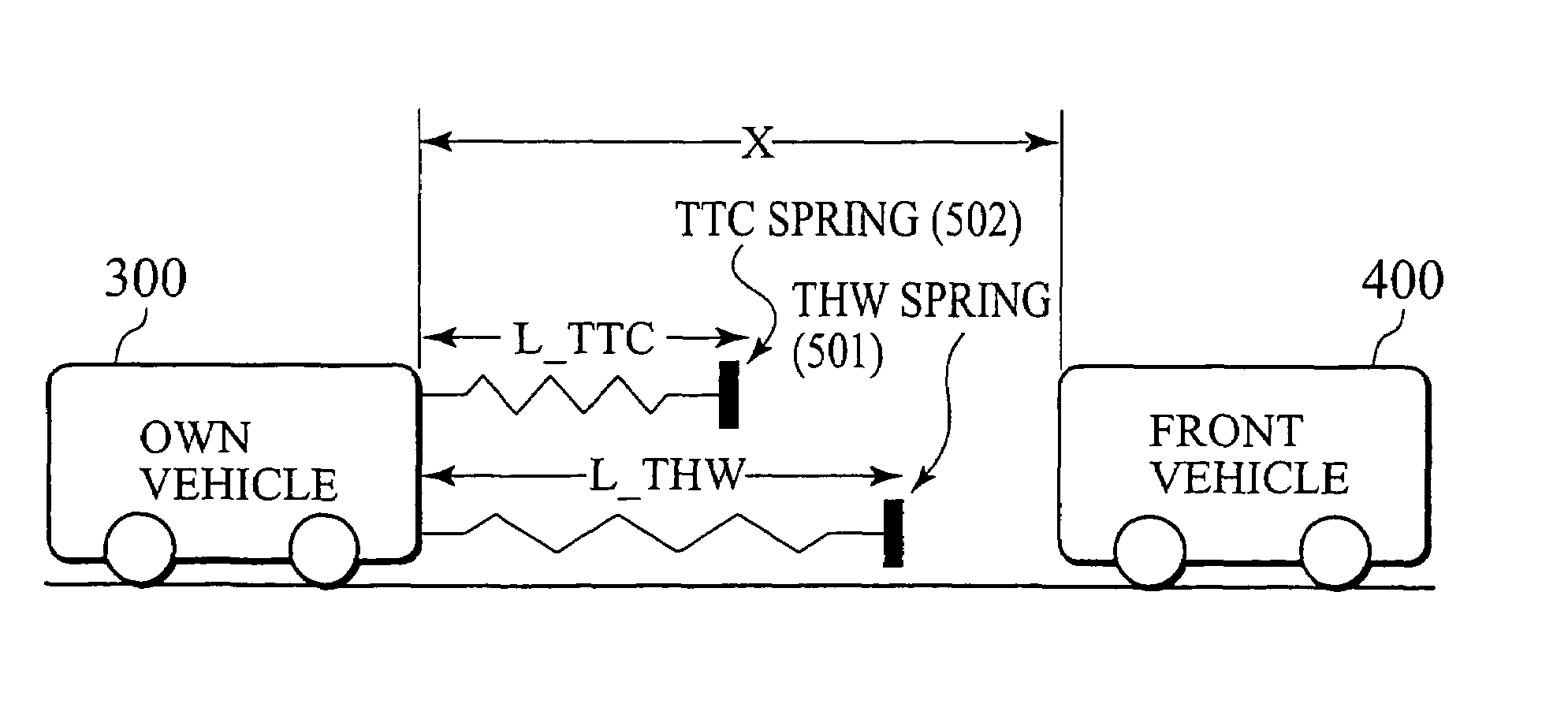Information providing apparatus for a vehicle
- Summary
- Abstract
- Description
- Claims
- Application Information
AI Technical Summary
Benefits of technology
Problems solved by technology
Method used
Image
Examples
first embodiment
[0047]FIG. 1 shows a drive control system of a vehicle employing a warning apparatus according to the first embodiment of the present invention.
[0048]The drive control system includes a radar 30, a vehicle speed sensor 1, an object detecting processor 2, a brake pedal 3, an accelerator pedal 4, a braking force controller 20, a driving force controller 10, a primary controller 5, and an engine 6. Although not particularly shown, the vehicle naturally includes other components such as a steering angle sensor. The driving force controller 10 controls the engine 6 so that the engine 6 may generate a driving force corresponding to a stroke of the accelerator pedal 4 as an accelerating operator. The driving force controller 10 is also designed to change the driving force in response to an external command.
[0049]FIG. 2 is a block diagram showing the driving force controller 10. The driving force controller 10 includes a calculator 11 to calculate a driving force demanded by the driver of t...
second embodiment
[0126]The second embodiment of the present invention employs the same components as those of the first embodiment shown in FIG. 1 and sets the parameters mentioned above in consideration of a deceleration behavior of a front vehicle. FIG. 21 shows steps carried out by the primary controller 5 according to the second embodiment. Compared with the steps as shown in FIG. 8, the steps of FIG. 21 additionally include step S51 to determine the deceleration of a front vehicle. This deceleration determining process determines the deceleration of a front vehicle according to, for example, a relative speed ΔV between the own vehicle and the front vehicle. After the deceleration determining process, the second embodiment proceeds to step S8 to set the parameters.
[0127]FIG. 22 shows the parameter setting process. Compared with the parameter setting process of FIG. 12, the process of FIG. 22 additionally has step S52. If an elapsed time after a lane change is within a predetermined value in step...
third embodiment
[0131]The third embodiment of the present invention employs the same components as those of the first embodiment shown in FIG. 1 and considers a lane change of a front vehicle when setting the parameters mentioned above. FIG. 23 shows steps carried out by the primary controller 5 according to the third embodiment. Compared with the flowchart of FIG. 8, the flowchart of FIG. 23 additionally includes step S61 to determine whether a front vehicle is changing its lane. This determination of whether a front vehicle is changing its lane refers to a detection result provided by, for example, the radar 30. If the own vehicle is changing its lane and if a front vehicle detected by the radar 30 shows no change, it is determined that the front vehicle detected by the radar 30 is changing its lane together with the own vehicle. The determination of whether the own vehicle is changing its lane is carried out according to the technique explained in the first embodiment with reference to FIG. 9. A...
PUM
 Login to View More
Login to View More Abstract
Description
Claims
Application Information
 Login to View More
Login to View More - R&D
- Intellectual Property
- Life Sciences
- Materials
- Tech Scout
- Unparalleled Data Quality
- Higher Quality Content
- 60% Fewer Hallucinations
Browse by: Latest US Patents, China's latest patents, Technical Efficacy Thesaurus, Application Domain, Technology Topic, Popular Technical Reports.
© 2025 PatSnap. All rights reserved.Legal|Privacy policy|Modern Slavery Act Transparency Statement|Sitemap|About US| Contact US: help@patsnap.com



